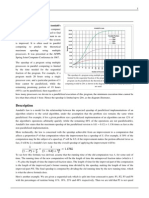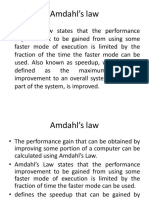0 ratings0% found this document useful (0 votes)
69 viewsIn Computer Programming
Amdahl's law states that in parallel programs, a few sequential instructions limit speedup so adding more processors may not speed up the program. This argues against parallel processing for some applications and overstating claims of parallel computing. However, others argue that parallel processing works best for large problems where scaling up processors improves throughput and performance.
Uploaded by
archumeenabaluCopyright
© © All Rights Reserved
Available Formats
Download as DOCX, PDF, TXT or read online on Scribd
0 ratings0% found this document useful (0 votes)
69 viewsIn Computer Programming
Amdahl's law states that in parallel programs, a few sequential instructions limit speedup so adding more processors may not speed up the program. This argues against parallel processing for some applications and overstating claims of parallel computing. However, others argue that parallel processing works best for large problems where scaling up processors improves throughput and performance.
Uploaded by
archumeenabaluCopyright
© © All Rights Reserved
Available Formats
Download as DOCX, PDF, TXT or read online on Scribd
You are on page 1/ 1
In computer programming, Amdahl's law is that, in a program with parallel
processing , a relatively few instruction s that have to be performed in
sequence will have a limiting factor on program speedup such that adding
more processor s may not make the program run faster. This is generally an
argument against parallel processing for certain applications and, in general,
against overstated claims for parallel computing. Others argue that the kinds
of applications for which parallel processing is best suited tend to be larger
problems in which scaling up the number of processors does indeed bring a
corresponding improvement in throughput and performance.
You might also like
- Amdahls Law - Advanced Computer ArchitectureNo ratings yetAmdahls Law - Advanced Computer Architecture2 pages
- Amdahl's Law, Also Known As Amdahl's Argument,: Parallel Computing Speedup Computer Architect Gene Amdahl AfipsNo ratings yetAmdahl's Law, Also Known As Amdahl's Argument,: Parallel Computing Speedup Computer Architect Gene Amdahl Afips3 pages
- FALLSEM2024-25 CSI3021 TH VL2024250103606 2024-10-01 Reference-Material-INo ratings yetFALLSEM2024-25 CSI3021 TH VL2024250103606 2024-10-01 Reference-Material-I9 pages
- Reevaluating Amdahl's Law and Gustafson's LawNo ratings yetReevaluating Amdahl's Law and Gustafson's Law9 pages
- Lecture 2 Amdahl's Law and Karp-Flatt Metric0% (1)Lecture 2 Amdahl's Law and Karp-Flatt Metric14 pages
- Unit4 Session5 Amdahls Law Gustafsons LawNo ratings yetUnit4 Session5 Amdahls Law Gustafsons Law15 pages
- Group Members:: Saeed Ud Din (15) Syed Amir Kazmi (07) Malik BaseerNo ratings yetGroup Members:: Saeed Ud Din (15) Syed Amir Kazmi (07) Malik Baseer9 pages
- Lecture 02-Amdahl's Law, Modern Hardware: ECE 459: Programming For PerformanceNo ratings yetLecture 02-Amdahl's Law, Modern Hardware: ECE 459: Programming For Performance13 pages
- Computer Hardware Engineering: IS1200, Spring 2015No ratings yetComputer Hardware Engineering: IS1200, Spring 201517 pages
- Unit 4 - Analytical Modeling of Parallel ProgramsNo ratings yetUnit 4 - Analytical Modeling of Parallel Programs37 pages
- Chapter (7) Performance Analysis Techniques: Asmaa Ismail Farah Basil Raua WaleedNo ratings yetChapter (7) Performance Analysis Techniques: Asmaa Ismail Farah Basil Raua Waleed46 pages
- Design Problem1 of CSE261 "Computer System Architecture"No ratings yetDesign Problem1 of CSE261 "Computer System Architecture"4 pages
- Attenuation in Neper: Attenuation in Decibel:: 1 2 LN 20 LogNo ratings yetAttenuation in Neper: Attenuation in Decibel:: 1 2 LN 20 Log3 pages
- Routing Protocols For MANET: Doc.: IEEE 802.11-00/1047r0No ratings yetRouting Protocols For MANET: Doc.: IEEE 802.11-00/1047r055 pages
- Chapter 1 - Fundamentals of Computer Design100% (1)Chapter 1 - Fundamentals of Computer Design40 pages

































































